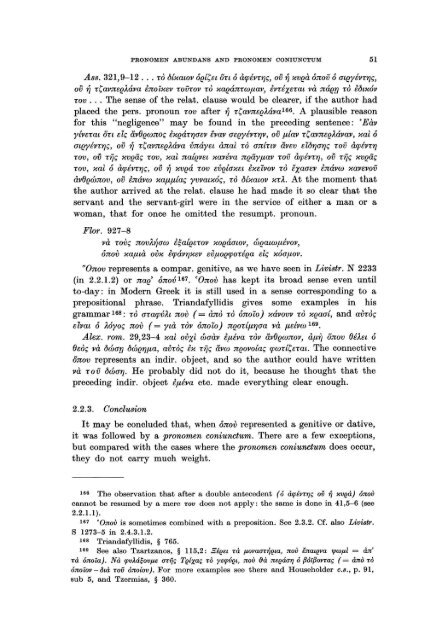Pronomen Abundans and Pronomen Coniunctum. A ... - DWC
Pronomen Abundans and Pronomen Coniunctum. A ... - DWC
Pronomen Abundans and Pronomen Coniunctum. A ... - DWC
You also want an ePaper? Increase the reach of your titles
YUMPU automatically turns print PDFs into web optimized ePapers that Google loves.
PRONOMEN ABUNDANS AND PRONOMEN CONIUNCTUM 51<br />
Ass. 321,9-12 . .. TO b{xawv óe{Cét {Ju Ó àrpévT'YJÇ, oiJ iJ xveà ónov ó ateyéVT'YJç,<br />
oiJ iJ TCavneeÄáva ènoixev TOVTOV TO xaeánTwflav, èvdxeTaL và náen TO Nuxóv<br />
TOV . .. The sense of the relat. clause would be clearer, if the author had<br />
placed the pers. pronoun TOV af ter iJ TCavneeÀáva166. A plausible reason<br />
for this "negligence" may be found in the preceding sentence: 'Eàv<br />
y{veTaL ou elç (iv()ewnoç èxeáT'YJaev evav aeeyéVT'YJV, oiJ fl{av TCavneeÄávav, xai ó<br />
ateyéVT'YJç, ov iJ TCavneeláva vnáyét ànai TO an{uv (ivev eïb'YJa'YJç TOV àrpévT'YJ<br />
TOV, oiJ TijÇ xveäç TOV, xai na{eveL xavéva neäYflav TOV àrpévT'YJ, oiJ Tijç xveäç<br />
rov, xai ó àrpévr'YJç, oiJ iJ xveá rov eve{axét èxetvov ro lxaaev ènávw xavevov<br />
àv()ewnov, oiJ ènávw xaflfl{aç yVVaLXÓÇ, TO b{xawv xrÄ. At the moment that<br />
the author arrived at the relat. clause he had made it so clear that the<br />
servant <strong>and</strong> the servant-girl were in the service of either a man or a<br />
woman, that for on ce he omitted the resumpt. pronoun.<br />
Flor. 927-8<br />
và TOVÇ novl~aw è~a{eerov xoeáawv, WeaLwflévov,<br />
ónov xaflLà ovx èrpáv'YJxev eVflOerpodea elç xóaflov.<br />
"Onov represents a compar. genitive, as we have seen in Livistr. N 2233<br />
(in 2.2.1.2) or nae' ónov 167. 'Onov has kept its broad sense even until<br />
to-day: in Modern Greek it is still used in a sense corresponding to a<br />
prepositional phrase. Tri<strong>and</strong>afyllidis gives some examples in his<br />
grammar 168: TO aTarpVlL nov (= àno ro ónolo) xávovv TO xeaa{, <strong>and</strong> aVToç<br />
elvaL ó Äóyoç nov (= yLà rov ónolo) neorlfl'YJaa và flelvw 169.<br />
Alex. rom. 29,23-4 xai ovXi waàv èfléva rov (iv()ewnov, àfl~ onov ()éleL ó<br />
()eoç và bwan bwe'YJfla, avroç èx rijç (ivw neovo{aç rpwrlCeTaL. The connective<br />
önov represents an indir. object, <strong>and</strong> so the author could have written<br />
và rov bwa'YJ. He probably did not do it, because he thought that the<br />
preceding indir. object èfléva etc. made everything clear enough.<br />
2.2.3. Conclusion<br />
It may be concluded that, when ónov represented a genitive or dative,<br />
it was followed by a pronomen coniunctum. There are a few exceptions,<br />
but compared with the cases where the pronomen coniunctum does occur,<br />
they do not carry much weight.<br />
166 The observation that af ter a double antecedent (6 àrpivTrJÇ ot) 1) '
















